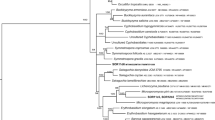Abstract
Soredia of the cyanobacterial lichenPeltigera didactyla were cultivated on soil substratum in the natural environment. Various developmental stages (germination, formation of a soredia field, differentiation of thallus lobes with soralia and fruiting bodies) were attained during a cultivation period of 6–7 months. Our field experiments revealed that the ephemeral pioneer lichenPeltigera didactyla has a short life cycle. Thus this lichen is a well-suited object for further investigations on thallus morphogenesis of lichens with cyanobionts.
Similar content being viewed by others
References
Ahmadjian, V., 1966: Artificial reestablishment of the lichenCladonia cristatella. — Science151: 199–201.
—, 1970: The culture and resynthesis ofEndocarpon pusillum andStaurothele clopima. — Lichenologist4: 259–267.
—, 1985: Artificial reestablishment of lichens. 4. Comparison between natural and synthetic thalli ofUsnea strigosa. — Lichenologist17: 149–165.
—, 1987: DNA and protoplast isolations from lichens and lichen symbionts. — Lichen Physiol. Biochem.2: 1–11.
Bertsch, A., Butin, H., 1967: Die Kultur der ErdflechteEndocarpon pusillum im Labor. — Planta72: 29–42.
Boissière, M. C., 1972: Mise en évidence cytochimique en microscopie électronique de polyglucosides de réserve chez desNostoc libres et lichénisés. — Compt. Rend. Hebd. Séances Acad. Sci. Paris, D,274: 2643–2646.
—, 1982: Cytochemical ultrastructure ofPeltigera canina: some features related to its symbiosis. — Lichenologist14: 1–27.
Bubrick, P., Galun, M., 1986: Spore to spore resynthesis ofXanthoria parietina. — Lichenologist18: 47–49.
Geitler, L., 1938: Beiträge zur Kenntnis der Flechtensymbiose. 7. Über Hymenialgonidien. — Arch. Protistenk.90: 489–501.
Honegger, R., 1986: Ultrastructural studies in lichens. 2. Myco- and photobiont cell wall surface layers and adhering crystalline lichen products in fourParmeliaceae. — New Phytol.103: 797–808.
—, 1987: Questions about pattern formation in the algal layer of lichens with stratified (heteromerous) thalli. InPeveling, E., (Ed.): Progress and problems in lichenology in the Eighties. — Bibl. Lichenol.25: 59–79. — Berlin, Stuttgart: J. Cramer in Gebr. Borntraeger.
Jahns, H. M., Herold, K., Beltman, H. A., 1978: Chronological sequence, synchronization and the induction of the development of fruit bodies inCladonia furcata var.furcata (Huds.)Schrad. — Nova Hedwigia30: 469–526.
—, 1982: Flechtenentwicklung an dicht benachbarten Standorten. — Herzogia6: 201–241.
Koriem, A. M., Ahmadjian, V., 1986: An ultrastructural study of lichenized and culturedNostoc photobionts ofPeltigera canina, Peltigera rufescens, andPeltigera spuria. — Endocyt. Cell Res.3: 65–78.
Marton, K., Galun, M., 1976: In vitro dissociation and reassociation of the symbionts of the lichenHeppia echinulata. — Protoplasma87: 135–143.
Ott, S., 1987a: The juvenile development of lichen thalli from vegetative diaspores. — Symbiosis3: 57–74.
—, 1987b: Die Besiedlung von Sanddünen durch Flechten. — Nova Hedwigia45: 53–81.
—, 1987c: Differences in the developmental rates of lichens. — Ann. Bot. Fennici24: 385–393.
Schuster, G., 1985: Die Jugendentwicklung von Flechten. — Ein Indikator für Klimabedingungen und Umweltbelastung. — Bibl. Lichenol.20: 1–206. — Berlin, Stuttgart: J. Cramer in Gebr. Borntraeger.
—, 1985: Artificial cultures of lichens in the natural environment. — Lichenologist17: 247–253.
Stahl, E., 1877: Beiträge zur Entwicklungsgeschichte der Flechten. 2. Über Hymenialgonidien. — Leipzig: Felix.
Stocker-Wörgötter, E., Türk, R., 1987: Die Resynthese der FlechteVerrucaria macrostoma unter Laborbedingungen. — Nova Hedwigia44: 55–68.
—, 1988: Culture of the cyanobacterial lichenPeltigera didactyla from soredia under laboratory conditions. — Lichenologist20: 369–375.
—, 1989a: The resynthesis of thalli ofDermatocarpon miniatum under laboratory conditions. — Symbiosis7: 37–50.
—, 1989b: Laborversuche zur Kultivierung von Blatt- und Strauchflechten und deren Komponenten. — Nova Hedwigia48: 207–228.
Author information
Authors and Affiliations
Additional information
Dedicated to Prof. DrLothar Geitler on the occasion of his 90th birthday.
Rights and permissions
About this article
Cite this article
Stocker-Wörgötter, E., Türk, R. Artificial cultures of the cyanobacterial lichenPeltigera didactyla (Peltigeraceae) in the natural environment. Pl Syst Evol 165, 39–48 (1989). https://doi.org/10.1007/BF00936033
Received:
Issue Date:
DOI: https://doi.org/10.1007/BF00936033




